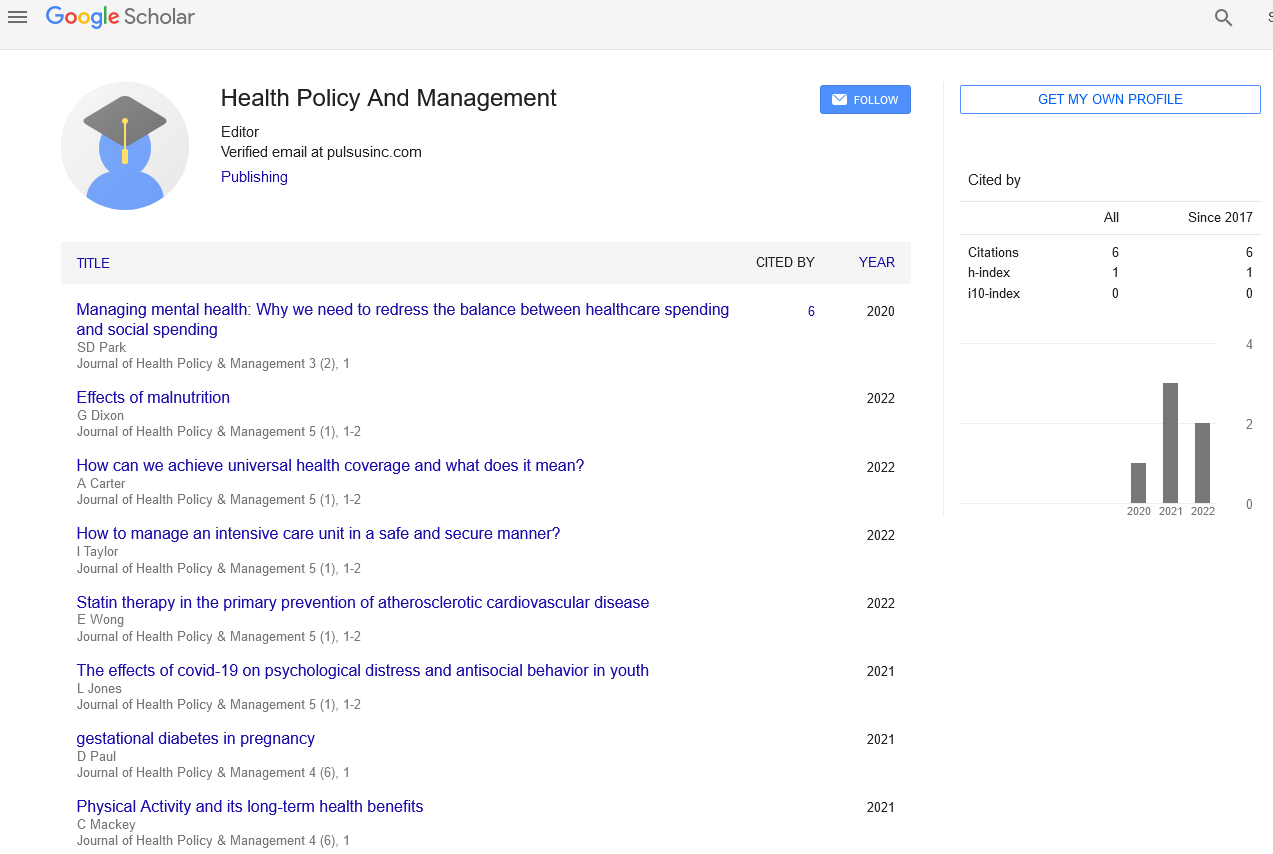Gestational diabetes in pregnancy
Received: 05-Nov-2021 Accepted Date: Nov 19, 2021; Published: 26-Nov-2021
Citation: Paul D. Gestational diabetes in pregnancy. J Health Pol Manage. 2021;4(6):5.
This open-access article is distributed under the terms of the Creative Commons Attribution Non-Commercial License (CC BY-NC) (http://creativecommons.org/licenses/by-nc/4.0/), which permits reuse, distribution and reproduction of the article, provided that the original work is properly cited and the reuse is restricted to noncommercial purposes. For commercial reuse, contact reprints@pulsus.com
Description
Gestational diabetes mellitus (GDM) is a condition in which a hormone made by the placenta prevents the body from the use of insulin effectively. Glucose builds up in the blood instead of being absorbed by the cells. Unlike type 1 diabetes, gestational diabetes isn't resulting from a lack of insulin, but by other hormones produced during pregnancy which can make insulin much less effective, a condition called insulin resistance. Gestational diabetes symptoms disappear following delivery. Gestational diabetes comes from hormonal changes, and the way our bodies convert food into energy. A hormone known as insulin that breaks down the glucose (sugar) from food and supplies it to our cells. Insulin maintains the level of glucose in our blood at a healthy level. But if insulin doesn’t work proper or we don’t have sufficient of it, sugar builds up in the blood and results in diabetes. During pregnancy, hormones can interfere with the way insulin works. It may not regulate your blood sugar levels like it’s supposed to, which could cause gestational diabetes. Women with gestational diabetes typically don’t have signs and symptoms or may chalk them up to pregnancy. Most find out that they have got it during a routine screening. Some of the signs and symptoms include: You’re thirstier than usual; you’re hungrier and eat extra than usual, you pee more than usual. Gestational diabetes may be caused When you eat, your pancreas releases insulin, a hormone that helps move a sugar known as glucose out of your blood in your cells, which use it for energy. During pregnancy, your placenta makes hormones that cause glucose to accumulate in your blood. Usually, your pancreas can send out sufficient insulin to handle it. But in case your body can’t make sufficient insulin or stops the use of insulin as it should, your blood sugar levels rise, and you get gestational diabetes. Gestational Diabetes may be diagnosed typically in the second half of pregnancy. Your medical doctor will check for it among weeks 24 and 28, or faster in case you are at high risk. Your medical doctor will provide you with a glucose tolerance test: You’ll drink 50 grams of glucose in a sweet drink, in order to raise your blood sugar. An hour later, you’ll take a blood glucose test to see how your body dealt with all that sugar. If the results show that your blood sugar is higher than a certain level, you’ll need a 3-hour oral glucose tolerance test-that means you’ll get a blood glucose test three hours after you drink a 100-gram glucose drink. Your medical doctor also can test you by having you fast for 12 hours, then giving you a 75-gram glucose drink and a 2-hour blood glucose test. If you’re at excessive risk but your test results are normal, your medical doctor may test you once more later in your pregnancy to ensure that you still don’t have it. Diet and Exercise for Gestational Diabetes are utmost important things to follow. Eat a healthful, low-sugar diet. Talk to your medical doctor to make sure you’re getting the nutrition you need. Follow a meal plan made for a person with diabetes: Trade sugary snacks like cookies, candy, and ice cream for natural sugars like fruits, carrots, and raisins. Add veggies and whole grains, and watch your portion sizes. Have 3 small meals together with or 3 snacks about the same times each day. Get 40% of your everyday calories from carbs and 20% from protein. Fifty percentage of the carbs should be complex, high-fiber carbs, with fats being between 25% and 30%. Aim for 20-35 grams of fiber a day. Foods consisting of whole-grain breads, cereals, and pasta; brown or wild rice; oatmeal; and veggies and fruits will help get you there. Limit your total fats to much less than 40% of your everyday calories. Saturated fats should be much less than 10% of all of the fats you consume. Eat a variety of foods to ensure that you get sufficient vitamins and minerals.





